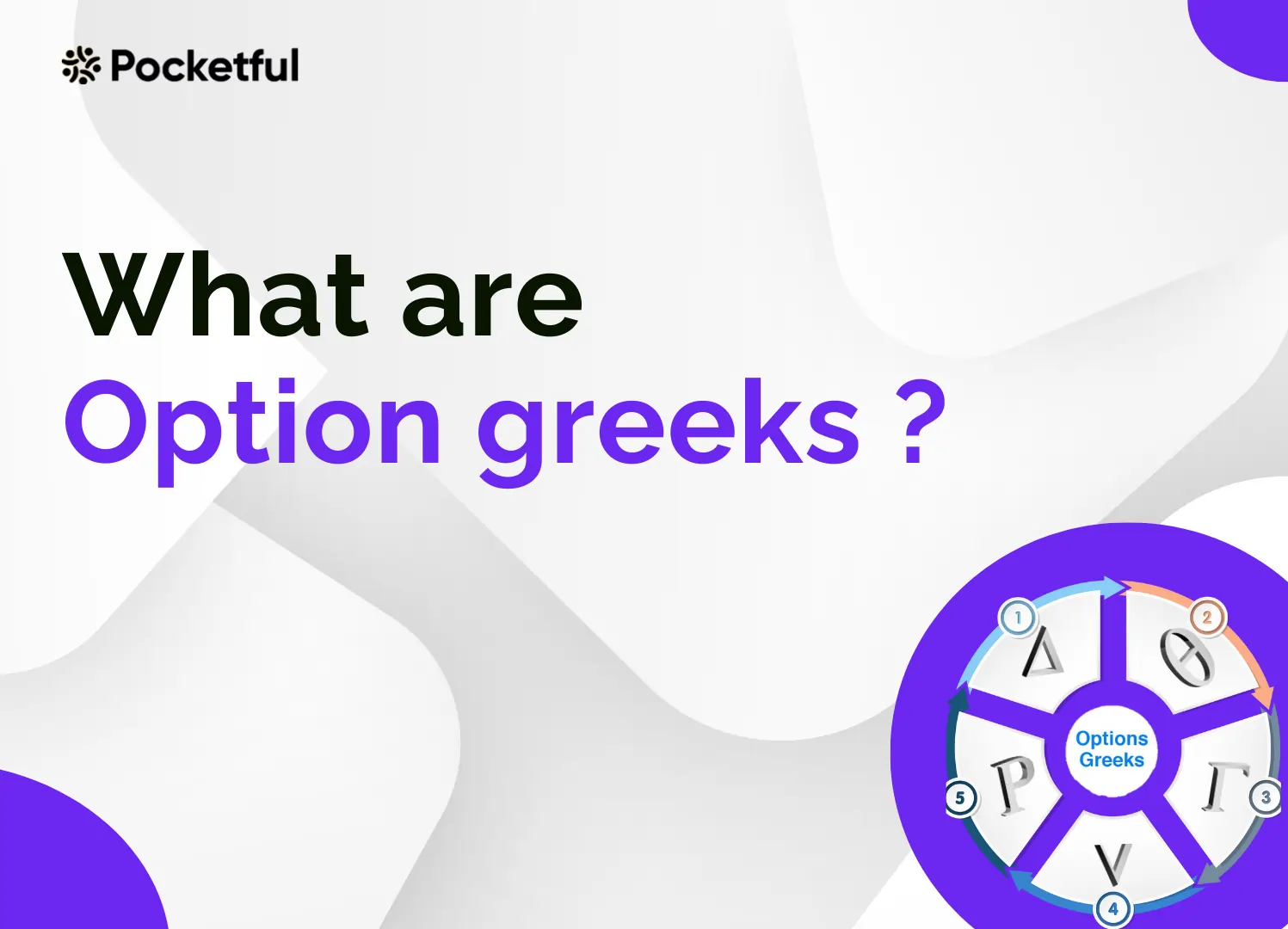| Type | Description | Contributor | Date |
|---|---|---|---|
| Post created | Pocketful Team | Jun-26-24 | |
| Add new links | Nisha | Mar-18-25 |
Read Next
- What is a Harami Candlestick Pattern?
- What is Average Traded Price in Stock Market
- What is MIS in Share Market?
- 7 Common Mistakes in Commodity Trading New Traders Must Avoid
- Brokerage Charges in India: Explained
- What is a BTST Trade?
- How to Do Algo Trading in India?
- What Is CMP in Stock Market?
- MTF Pledge vs Margin Pledge – Know the Differences
- Physical Settlement in Futures and Options
- List of Best Commodity ETFs in India
- Bullish Options Trading Strategies Explained for Beginners
- Best Brokers Offering Free Trading APIs in India
- Top Discount Brokers in India
- Best Charting Software for Trading in India
- Benefits of Intraday Trading
- What are Exchange Traded Derivatives?
- What is Margin Shortfall?
- What is Central Pivot Range (CPR) In Trading?
- Benefits of Algo Trading in India
What are Option Greeks?

You are anticipating that Indian markets will go up in the coming days and bought a call option of Nifty 50 Call Option. But, do you know what the key factors are that will affect the price of the option you bought?
Well, in this blog, we will discuss Option Greeks and how they work.
Option Greeks Definition
Option Greeks are the key factors that influence the option prices. They are denoted in Greek letters and define different risk measures. There are five primary Greeks which indicate how sensitive an option is to different risks:
- Delta: It measures how much an option’s premium may change if the underlying price changes by one rupee.
- Gamma: It measures the delta’s rate of change over time, and the rate of change in the underlying asset because of that.
- Theta: It measures time decay in the value of an option or its premium.
- Vega: It measures the risk of change in implied volatility.
- Rho: It is the change in option price because of a change in risk-free rate.
The values for each of the Greeks are derived from mathematical models, like the Black-Scholes option pricing model. The derived values are then used to calculate the theoretical price of an option, which can then be compared to the actual price to see if the option is overpriced or underpriced.
Option Greeks Calculation

Let’s understand how Greeks are calculated mathematically. Nowadays, there are plenty of option calculators available online; we just need to feed the values, and the job of finding the value for each option would be performed by the option calculator. The input values generally for any option pricing model are more or less the same, here are the variables used in the Black Scholes model:
- Underlying Price (e.g. Current Stock Price)
- Strike Price
- Time to Expiration
- Volatility
- Interest rate or risk-free rate
- Dividend, if applicable
Only one variable from the abovementioned 6 variables, i.e., the Strike Price, remains constant, and the other variables fluctuate, which means the option price changes over the life of the option. Hence, the input of fluctuating variables should be correct, or else the output value will be flawed.
Black-Scholes Assumptions

To calculate the price of an option, there are certain assumptions of the Black-Scholes Model:
- No dividends are paid out during the life of the option.
- Markets are random (i.e., market movements cannot be predicted).
- There are no transaction costs in buying the option.
- The risk-free rate and volatility of the underlying asset are known and are constant.
- The returns of the underlying asset are normally distributed.
- The option is European and can only be exercised at expiration. (In contrast, American options could be exercised before the expiration date).
There are many models available today for pricing options. However, even today, the Black Scholes model remains popular. The Black Scholes model was introduced in the year 1973. At that time, it was only utilized for pricing European options, and that too was used for the stocks that did not pay dividends. However, following several modifications, it can now be utilized for a broader range of assets, including dividend paying stocks.
Read Also: Option Chain Analysis: A Detail Guide for Beginners
Types of Option Greeks

Let’s understand the Greeks further one by one:
1. Option Greek Delta
The symbol for Delta is Δ. It is the change in the option’s price relative to the change in the underlying price or stock price. If the price of the underlying asset increases, the price of the option would Increase with a certain amount because of Delta. For example, a call option with a Delta of 50 is expected to increase by 50 paise if the underlying price increases by one rupee. So, Delta is the speed at which the option price changes for every one-point change in underlying. Delta values range from -1 to +1, with 0 representing the situation where the premium barely moves relative to price changes in the underlying stock.
2. Option Greek Gamma
Gamma is a measure of the change in Delta relative to the changes in the price of the underlying asset. If the price of the asset increases, the options delta would also change in the Gamma amount. For example, if the ITC share price is 300, and the call option of 320 strike price has a delta of 30 and a gamma of 2. If the share price of ITC increases to 301, the delta is now 32. The objective of Gamma is to understand changes in delta, forecast price movements, and manage risk and option positions.
Gamma can be positive if an option is long on a call or put, and negative if an option is short on a call or put. At-the-money (ATM) options have the highest gamma because their deltas are most sensitive to price changes. Deep in the money (ITM) and far out of the money (OTM) options have lower gamma because their deltas don’t change as quickly.
3. Option Greek Vega
Theta measures the sensitivity of the option price relative to the option’s time to maturity. It tells us how much an option’s premium may decay each day, considering all other factors remain constant. The theta option in Greek is also referred to as time decay. Option sellers love theta because they get an opportunity to profit from the decay in premium.
Mostly, theta is negative for options. It shows the most negative value when the option is at the money. Theta accelerates as expiration approaches, and options lose value over time. Higher Theta in OTM options is an indication that the value of the option will decay more rapidly over time.
4. Option Greek Theta
Theta measures the sensitivity of the option price relative to the option’s time to maturity. It tells us how much an option’s premium may decay each day, considering all other factors remain constant. The theta option in Greek is also referred to as time decay. Option sellers love theta because they get an opportunity to profit from the decay in premium.
Mostly, theta is negative for options. It shows the most negative value when the option is at the money. Theta accelerates as expiration approaches, and options lose value over time. Higher Theta in OTM options is an indication that the value of the option will decay more rapidly over time.
5. Option Greek Rho
Rho measures the sensitivity of the option price relative to the interest rates. If the benchmark or risk-free interest rate is increased by a percent, the option price would change by the value of the RHO. It’s expressed as the amount of money an option will lose or gain with a 1% change in interest rates. Rho can be either positive or negative depending on whether the position is long or short, and whether the option is a call or a put. Long calls and short puts have a positive rho, while long puts and short calls have a negative rho.
The RHO is known to be the least significant among other option Greeks because the option prices are generally less sensitive to interest rate changes than to changes in other parameters.
Read Also: What is Options Trading?
Conclusion
All of the above discussed option greeks play an integral role in trading. They not only help predict market movement but also assist in hedging open positions. Such hedges help limit downside risk of the trader while maximising upside potential. However, it is extremely important to understand that incorrect or partial knowledge of these option greeks can significantly reduce your profit potential. Therefore, it is imperative that you perform extensive research before investing your hard-earned money.
Frequently Asked Questions (FAQs)
How many Option Greeks are there?
There are five Option Greeks: Delta, Theta, Gamma, Vega, and Rho.
What is the objective of Option Greeks?
Option Greeks measure an option’s sensitivity to the changes in the price of the underlying and to manage risks.
What is the meaning of Gamma in Option Greeks?
It is the rate of change in an options’ Delta and the underlying asset’s price.
How to manage the risk of Gamma in Options Trading?
One can manage the risk of Gamma by initiating a hedge position. Further, one can consider squaring off the position if the option contract is near to the expiration.
Is Rho significant among other Option Greeks?
The Rho is known to be the least significant among other Option Greeks because the option prices are generally less sensitive to interest rate changes than to changes in other parameters.
Disclaimer
The securities, funds, and strategies discussed in this blog are provided for informational purposes only. They do not represent endorsements or recommendations. Investors should conduct their own research and seek professional advice before making any investment decisions.
Article History
Table of Contents
Toggle